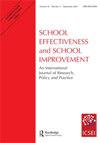Country and school family composition’s effects on mathematics achievement
IF 2.8
3区 教育学
Q1 EDUCATION & EDUCATIONAL RESEARCH
引用次数: 4
Abstract
ABSTRACT Family structures are associated with achievement outcomes, but the percentage of children residing in different family structures has changed over time. In this paper, we revisit data from the Programme for International Student Assessment (PISA) to determine whether previous findings have also changed over time. Drawing on PISA 2012, we employ multilevel modelling to examine whether school and country compositional factors are still salient a decade later. The final analytical sample included 172,452 students in 7,391 schools from 24 countries. The results indicate, like previous research, an educational disadvantage for students that attend schools with a large concentration of children from single-parent homes. However, this disadvantage is largely due to the lower socioeconomic composition of these schools. At the country level, there is little support for the hypothesis that the achievement gap between students from two- versus one-parent households is greater in countries with higher percentages of single-parent families.农村和学校家庭构成对数学成绩的影响
家庭结构与成就有关,但生活在不同家庭结构中的儿童的比例随着时间的推移而变化。在本文中,我们重新审视了国际学生评估项目(PISA)的数据,以确定以前的发现是否也随着时间的推移而发生了变化。利用2012年国际学生评估项目,我们采用多层次模型来检验十年后学校和国家的构成因素是否仍然突出。最终的分析样本包括来自24个国家7391所学校的172452名学生。与之前的研究一样,研究结果表明,在单亲家庭孩子集中的学校上学的学生在教育上处于劣势。然而,这种劣势很大程度上是由于这些学校的社会经济构成较低。在国家层面上,几乎没有证据支持这样一种假设,即在单亲家庭比例较高的国家,双亲家庭与单亲家庭的学生之间的成绩差距更大。
本文章由计算机程序翻译,如有差异,请以英文原文为准。
求助全文
约1分钟内获得全文
求助全文
来源期刊

School Effectiveness and School Improvement
EDUCATION & EDUCATIONAL RESEARCH-
CiteScore
6.60
自引率
0.00%
发文量
23
期刊介绍:
School Effectiveness and School Improvement presents information on educational effectiveness, practice and policy-making across primary, secondary and higher education. The Editors believe that the educational progress of all students, regardless of family background and economic status, is the key indicator of effectiveness and improvement in schools. The journal strives to explore this idea with manuscripts that cover a range of subjects within the area of educational effectiveness at the classroom, school or system level, including, but not limited to: •Effective pedagogy •Classroom climate •School ethos and leadership •School improvement and reform programmes •Systemwide policy and reform
 求助内容:
求助内容: 应助结果提醒方式:
应助结果提醒方式:


